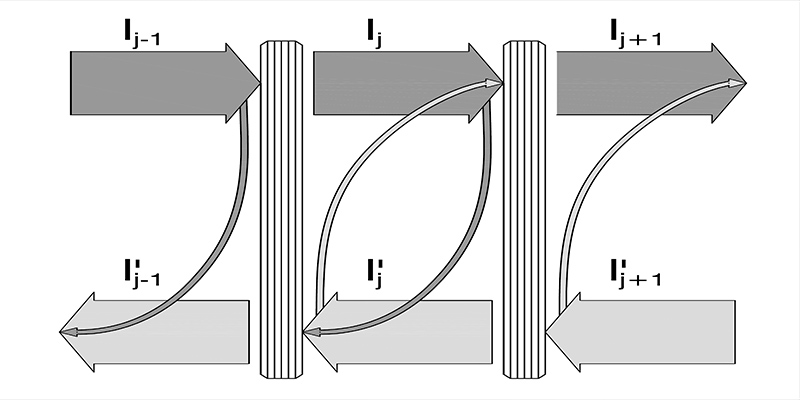Downloads
DOI:
https://doi.org/10.7480/jfde.2016.4-3.1146Keywords:
Climatic loads, IGU temperature, facades, insulated glass units IGUAbstract
The oil crises of the 1970s increased the awareness of energy efficiency. Over the past forty years, single- and double-glazed windows have evolved into a range of modern insulating glass solutions for windows and facades. In the mid-1990s the climatic loading of double-glazed units (DGUs) was investigated and design rules were developed for use in practice. Even though those rules were at the time developed for DGUs, they have recently also been used for the design of modern triple-glazed units (TGUs) and multilayer facade systems. So far, no research has posed the question whether this design process, and in particular the temperature differences that have been determined for DGUs, can be applied to other systems. It is therefore the aim of this paper to determine the governing temperatures in insulated glass units (IGUs) under modern boundary conditions. To do this, the thermal behavior of TGUs, multilayer facade systems and solar shading is investigated in detail. A simple calculation model is developed, which can be used to determine the glass temperatures in various facade configurations in accordance with the relevant standards. The results show that while parts of the existing requirements are still valid, there are distinct differences in the requirements for more modern applications.
How to Cite
Published
Issue
Section
License
Copyright (c) 2016 Thomas Wüest, Andreas Luible

This work is licensed under a Creative Commons Attribution 4.0 International License.
Authors or their institutions retain copyright to their publications without restrictions.
References
Balocco, C. (2002). A simple model to study ventilated facades energy performance. Energy and Building(34), p. 469-475.
Burkhard + Partner AG. (19. Oktober 2015). Referenzliste. Available at http://www.burckhardtpartner.ch/tl_files/content/images/Referenzliste_all-GF_d_131206.pdf
CEN. (2003). EN 13363-1 Sonnenschutzeinrichtungen in Kombination mit Verglasungen - Berechnung der Solarstrahlung und des Lichtransmissionsgrades - Teil 1. Brussels: European Comitee for Standarization.
CEN. (2005). EN 13363-2 - Sonnenschutzeinrichtungen in Kombinaton mit Verglasungen. Brussels: European Comitee for Standardization.
CEN. (2007). EN ISO 6946 Bauteile - Wärmedurchlasswiderstand und Wärmedurchgangskoeffizient. Brussels: European Comitee for Standardization.
CEN. (2011). EN 410, Glas im bauwesen, Bestimmung der lichttechnischen und strahlungsphysikalischen Kenngrössen von Verglasungen. Brussels: European Comitee for Standardization.
CEN. (2011). SN EN 673 - Glas im Bauwesen - Bestummung des Wärmedurchgangskoeffizienten (U-Wert). Brussels: European Comitee for Standardization.
CEN. (Juni 2013). prEN 16612:2013 Glas im Bauwesen - Bestimmung des Belastungswiderstandes von Glasscheiben durch Berechnung und Prüfung. Brussels: European Comitee for Standardization.
DIBt. (1998). Technische Regeln für die Verwendung von linienförmig gelagerten Verglasungen. BerliDeun: DIBt.
DIBt. (2006). Technische Regeln für die Verwendung von linienförmig gelagerten Verglasungen. Berlin: DIBt.
DIN. (2010). DIN 18008-1 Glas im Bauwesen -Teil 1: Begriffe und allgemeine Grundlagen. Berlin: German Institute for Standardization.
DIN. (2010). DIN 18008-2 Glas im Bauwesen -Teil 2: Linienförmig gelagerte Verglasungen. Berlin: German Institute for Standardization.
Feldmeier, F. (4/ 1991). Belastung von Isolierglas durch Wind und Klimaänderung. Fenster und Fassade, p. 89-97.
Feldmeier, F. (1995). Entwicklung eines vereinfachten verfahrens zur Berücksichtigung der Klimabelastung bei der Bemessung von Isolierglas bei Überkopfverglasungen. Stuttgart: Fraunhofer IRB Verlag.
Feldmeier, F. (2000). Die klimatische Belastung von Isolierglas bei nicht trivialer Geometrie. VDI Berichte (No. 1527), p. 185-201.
Feldmeier, F. (2006). Klimabelastung und Lastverteilung bei Mehrscheibeninsolierglas. Stahlbau (75), p. 467-478.
Feldmeier, F. (4/ 2009). Kleine Dreifach-Isoliergläser. Fassade, p. 5-7.
Feldmeier, F. (07/ 2009). Klimabelastung von Dreifach-Isolierglas. Glas+Rahmen, p. 32-34.
Feldmeier, F. (2011). Bemessung von Dreifach-Isolierglas. Stahlbau Spezial, p. 75-80.
Frank, T. (2010). Bauphysik, Bau & Energie. Zurich: Hochschulverlag ETH Zürich.
Glas Trösch AG. (16. Oktober 2015). glaCE. Available at http://www.glastroesch.ch/services/berechnungsprogramme/silverstar-glace/glace.html
Manz, H. (2010). Bauphysik II.
Manz, H., & Frank, T. (2005). Thermal simulation of buildings with double-skin fac¸ades. Energy and Buildings (37), p. 1114-1121.
Meteotest. (2015). METEONORM 7. Available at http://meteonorm.com/de/downloads
Pasquay, T. (2003). Thermisches Verhalten von Doppelfassaden an drei Gebäuden. Bauphysik (25), p. 220-224.
Penkova, N., Iliev, V., & Neugebauer, N. (2013). Thermal-mechanical behaviour of insulating glass units. COST TU0905, Mif-therm Conference on Structural Glass. London: Taylor & Francis Group.
Penkova, N., Iliev, V., Zashova, L., & Neugebauer, J. (2014). Thermal load analysis of cylindrically bent insulating glass units. In C. G. 4 (Ed.). London: Taylor & Francis Group.
Reick, M. (26. Oktober 2015). DIN 18008: Mehr Leid als Freud? Available at http://www.glaswelt.de/Gentner.dll/PL_30003_642507
Stoll, J. (Mai 2005,Bd. 56, Nr. 5). Fenstermodell. HLH, p. 32-39.
